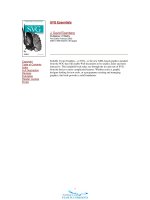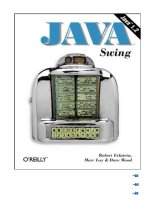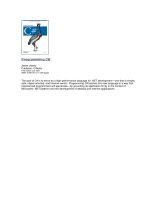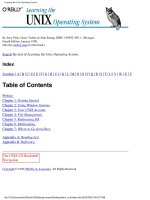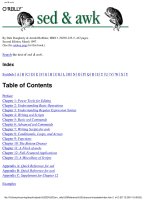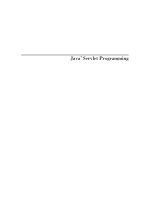o'reilly - blast
Bạn đang xem bản rút gọn của tài liệu. Xem và tải ngay bản đầy đủ của tài liệu tại đây (3.29 MB, 312 trang )
[ Team LiB ]
• Table of Contents
• Index
• Reviews
• Examples
• Reader Reviews
• Errata
BLAST
By Joseph Bedell, Ian Korf, Mark Yandell
Publisher: O'Reilly
Pub Date: July 2003
ISBN: 0-596-00299-8
Pages: 360
BLAST (Basic Local Alignment Search Tool) is a set of similarity search programs that explore all of the available
sequence databases for protein or DNA. BLAST is the only book completely devoted to this popular and important
technology and offers biologists, computational biology students, and bioinformatics professionals a clear
understanding of this program. This book shows you how to get specific answers with BLAST and how to use the
software to interpret results. If you have an interest in sequence analysis this is a book you should own.
[ Team LiB ]
[ Team LiB ]
• Table of Contents
• Index
• Reviews
• Examples
• Reader Reviews
• Errata
BLAST
By Joseph Bedell, Ian Korf, Mark Yandell
Publisher: O'Reilly
Pub Date: July 2003
ISBN: 0-596-00299-8
Pages: 360
Copyright
Forward
Preface
Audience for This Book
Structure of This Book
A Little Math, a Little Perl
Conventions Used in This Book
URLs Referenced in This Book
Comments and Questions
Acknowledgments
Part I: Introduction
Chapter 1. Hello BLAST
Section 1.1. What Is BLAST?
Section 1.2. Using NCBI-BLAST
Section 1.3. Alternate Output Formats
Section 1.4. Alternate Alignment Views
Section 1.5. The Next Step
Section 1.6. Further Reading
Part II: Theory
Chapter 2. Biological Sequences
Section 2.1. The Central Dogma of Molecular Biology
Section 2.2. Evolution
Section 2.3. Genomes and Genes
Section 2.4. Biological Sequences and Similarity
Section 2.5. Further Reading
Chapter 3. Sequence Alignment
Section 3.1. Global Alignment: Needleman-Wunsch
Section 3.2. Local Alignment: Smith-Waterman
Section 3.3. Dynamic Programming
Section 3.4. Algorithmic Complexity
Section 3.5. Global Versus Local
Section 3.6. Variations
Section 3.7. Final Thoughts
Section 3.8. Further Reading
Chapter 4. Sequence Similarity
Section 4.1. Introduction to Information Theory
Section 4.2. Amino Acid Similarity
Section 4.3. Scoring Matrices
Section 4.4. Target Frequencies, lambda, and H
Section 4.5. Sequence Similarity
Section 4.6. Karlin-Altschul Statistics
Section 4.7. Sum Statistics and Sum Scores
Section 4.8. Further Reading
Part III: Practice
Chapter 5. BLAST
Section 5.1. The Five BLAST Programs
Section 5.2. The BLAST Algorithm
Section 5.3. Further Reading
Chapter 6. Anatomy of a BLAST Report
Section 6.1. Basic Structure
Section 6.2. Alignments
Chapter 7. A BLAST Statistics Tutorial
Section 7.1. Basic BLAST Statistics
Section 7.2. Using Statistics to Understand BLAST Results
Section 7.3. Where Did My Oligo Go?
Chapter 8. 20 Tips to Improve Your BLAST Searches
Section 8.1. Don't Use the Default Parameters
Section 8.2. Treat BLAST Searches as Scientific Experiments
Section 8.3. Perform Controls, Especially in the Twilight Zone
Section 8.4. View BLAST Reports Graphically
Section 8.5. Use the Karlin-Altschul Equation to Design Experiments
Section 8.6. When Troubleshooting, Read the Footer First
Section 8.7. Know When to Use Complexity Filters
Section 8.8. Mask Repeats in Genomic DNA
Section 8.9. Segment Large Genomic Sequences
Section 8.10. Be Skeptical of Hypothetical Proteins
Section 8.11. Expect Contaminants in EST Databases
Section 8.12. Use Caution When Searching Raw Sequencing Reads
Section 8.13. Look for Stop Codons and Frame-Shifts to find Pseudo-Genes
Section 8.14. Consider Using Ungapped Alignment for BLASTX, TBLASTN, and
TBLASTX
Section 8.15. Look for Gaps in Coverage as a Sign of Missed Exons
Section 8.16. Parse BLAST Reports with Bioperl
Section 8.17. Perform Pilot Experiments
Section 8.18. Examine Statistical Outliers
Section 8.19. Use links and topcomboN to Make Sense of Alignment Groups
Section 8.20. How to Lie with BLAST Statistics
Chapter 9. BLAST Protocols
Section 9.1. BLASTN Protocols
Section 9.2. BLASTP Protocols
Section 9.3. BLASTX Protocols
Section 9.4. TBLASTN Protocols
Section 9.5. TBLASTX Protocols
Part IV: Industrial-Strength BLAST
Chapter 10. Installation and Command-Line Tutorial
Section 10.1. NCBI-BLAST Installation
Section 10.2. WU-BLAST Installation
Section 10.3. Command-Line Tutorial
Section 10.4. Editing Scoring Matrices
Chapter 11. BLAST Databases
Section 11.1. FASTA Files
Section 11.2. BLAST Databases
Section 11.3. Sequence Databases
Section 11.4. Sequence Database Management Strategies
Chapter 12. Hardware and Software Optimizations
Section 12.1. The Persistence of Memory
Section 12.2. CPUs and Computer Architecture
Section 12.3. Compute Clusters
Section 12.4. Distributed Resource Management
Section 12.5. Software Tricks
Section 12.6. Optimized NCBI-BLAST
Part V: BLAST Reference
Chapter 13. NCBI-BLAST Reference
Section 13.1. Usage Statements
Section 13.2. Command-Line Syntax
Section 13.3. blastall Parameters
Section 13.4. formatdb Parameters
Section 13.5. fastacmd Parameters
Section 13.6. megablast Parameters
Section 13.7. bl2seq Parameters
Section 13.8. blastpgp Parameters (PSI-BLAST and PHI-BLAST)
Section 13.9. blastclust Parameters
Chapter 14. WU-BLAST Reference
Section 14.1. Usage Statements
Section 14.2. Command-Line Syntax
Section 14.3. WU-BLAST Parameters
Section 14.4. xdformat Parameters
Section 14.5. xdget Parameters
Part VI: Appendixes
Appendix A. NCBI Display Formats
Section A.1. Brief Descriptions
Section A.2. Detailed Descriptions and Examples
Appendix B. Nucleotide Scoring Schemes
Appendix C. NCBI-BLAST Scoring Schemes
Section C.1. NCBI-BLAST Matrices and Gap Costs
Appendix D. blast-imager.pl
Appendix E. blast2table.pl
Glossary
Numbers
A-G
H-U
Colophon
Index
[ Team LiB ]
[ Team LiB ]
Copyright
Copyright © 2003 O'Reilly & Associates, Inc.
Printed in the United States of America.
Published by O'Reilly & Associates, Inc., 1005 Gravenstein Highway North, Sebastopol, CA 95472.
O'Reilly & Associates books may be purchased for educational, business, or sales promotional use. Online editions
are also available for most titles (). For more information, contact our corporate/institutional
sales department: (800) 998-9938 or
Nutshell Handbook, the Nutshell Handbook logo, and the O'Reilly logo are registered trademarks of O'Reilly &
Associates, Inc. Many of the designations used by manufacturers and sellers to distinguish their products are claimed
as trademarks. Where those designations appear in this book, and O'Reilly & Associates, Inc. was aware of a
trademark claim, the designations have been printed in caps or initial caps. The association between the image of a
coelacanth and the topic of BLAST is a trademark of O'Reilly & Associates, Inc.
While every precaution has been taken in the preparation of this book, the publisher and authors assume no
responsibility for errors or omissions, or for damages resulting from the use of the information contained herein.
[ Team LiB ]
[ Team LiB ]
Forward
Reading a book such as this brings home how much BLAST-now in its teenage years-has grown, and provides an
occasion for fond reflection. BLAST was born in the first months of 1989 at the National Center for Biotechnology
Information (NCBI). The Center had been created at the National Institutes of Health in November 1988, by an act
of the U.S. Congress, to foster the development of a field that then had no widely accepted name, but which has since
come to be known as "Bioinformatics." In early 1989, David Lipman, my post-doctoral advisor, who at the time was
perhaps best known as a codeveloper of the FASTA program, was appointed director of NCBI. On the first of
March we moved into new offices at the National Library of Medicine.The NCBI was small, but had large ambitions,
and already a number of friends. Several of these well-wishers made it a point to drop by for a visit. Gene Myers, a
computer scientist then at Arizona, arrived during a week in which Science was hyping a special-purpose computer
chip for sequence comparison. He and David, software partisans both, were unimpressed and over dinner resolved to
do better. Their original idea was to find not subtle sequence similarities, but fairly obvious ones, and to do it in a flash.
Gene pursued a rigorous approach at first, but David, with a fine Darwinian wisdom, was willing to settle for
imperfection. If one were to gamble, what kind of match could one expect a strong alignment to contain? Detailed
algorithmic and code development on BLAST by Webb Miller-later to be joined by Warren Gish-had hardly begun
before Sam Karlin, a Stanford mathematician, came calling. I had approached him a few months earlier with a
conjecture concerning the asymptotic behavior of optimal ungapped local sequence alignments. Since then, he had
spun this conjecture into a beautiful theory. Now, for the first time, rigorous statistics were available for alignment
scoring systems of more than academic interest, and the essential nature of amino acid substitution matrices also began
to come into clear focus. This theory dovetailed perfectly with the work that had just started on BLAST: both
informing the selection of its algorithmic parameters, and yielding units for the alignment scores produced.
Although David chose BLAST's name as a bit of a pun on "FASTA" (it was only later that I realized "BLAST" to be
an acronym), the new program was never intended to vie with the earlier one. Rather, the idea was to turn the
"threshold parameter" way up, to find undoubted homologies before you take more than one sip of coffee. It surprised
us all when BLAST started returning most weak similarities as well. Thus was born a sort of friendly competition with
Bill Pearson's and David's earlier creation. From the start, BLAST had two major advantages to FASTA and one
major disadvantage. In the plus column, BLAST was indeed much the faster, and it also boasted Sam's new statistics,
which turned raw scores into E-values. However, BLAST could only produce ungapped local alignments, thereby
often eliding large regions of similarity and sometimes completely missing weak alignments that FASTA, in its most
sensitive but slowest mode, was able to find. These points of comparative advantage were healthy for both programs.
In time, FASTA fit its scores to the extreme value distribution, yielding reliable statistical evaluations of its output. And
by the mid '90s, Warren Gish's WU-BLAST from Washington University, and NCBI's BLAST releases, introduced
gapped alignments, using differing algorithmic strategies. The result, at least for protein sequence comparisons, is that
BLAST and FASTA have converged in many important ways, although there still remain significant differences.
The programs comprehended by the name "BLAST" have multiplied astonishingly in the nearly 15 years since the first
one was conceived. Learning the best way to use these various programs for research can be a challenge, and this
book is a significant aid.While BLAST's developers have done their best to make the programs' default behavior the
most generally applicable, a sophisticated user still has many issues to consider.
To achieve speed, BLAST is a heuristic program. It isn't guaranteed to find every local alignment that passes its
reporting criteria, and there are an array of parameters that control the shortcuts it takes.With the introduction of
gapped alignments, the programs' complexity increased, as did the number of parameters that influence BLAST's
tradeoff of speed and sensitivity. In a certain sense, however, these mechanics are the least important for a user to
understand because, except for the occasional appearance or disappearance of a weak similarity, they don't greatly
effect the programs' output. Perhaps of more importance is an understanding of attendant matters that are relevant to
the effective use of any local alignment search method, such as the filtering of "low-complexity" sequence regions, the
proper choice of scoring systems, and the correct interpretation of statistical significance. This book deals with these
and many other matters, and nicely combines theoretical considerations with practical advice informed by these
considerations.
The BLAST programs have been the fruit of much hard work by scores of talented programmers and scientists. This
work continues, linking BLAST output to other databases, improving alignment formatting options, refining the types
of queries that may be performed. Newer offshoots, such as PSI-BLAST for protein profile searches, also continue
under development, and BLAST is thus a moving and a growing target. This book should prove a valuable guide for
those wishing to use the programs to best effect.
—Stephen Altschul
June 26, 2003
[ Team LiB ]
[ Team LiB ]
Preface
The second half of the 20th century was witness to incredible advances in molecular biology and computer
technology. Only 50 years after identifying the chemical structure of DNA (1953), the sequence of the human genome
has been determined and can be downloaded to a computer small enough to fit in your hand. The pace of science can
be truly dizzying. So what do you do when you literally have the book of life in the palm of your hand? Well, you read
it of course. Unfortunately, it's much easier to read the book of life than to understand it, and one of the great quests
of the 21st century will be unraveling its mysteries. One particularly fruitful approach to deciphering the book of life
has been through comparative studies, such as those between mouse and human.
Comparisons between the human and mouse genomes show how little has changed since humans and mice last shared
a common ancestor around 75 million years ago. Very few genes are unique to humans or mice, and in general the
genes are more than 80% identical at the sequence level. However, genes account for a small fraction of these
genomes and the majority of sequence is not recognizably similar. This is where BLAST, the Basic Local Alignment
Search Tool, comes in. BLAST is useful for finding similarities between biological sequences, be they DNA, RNA, or
protein. Sequence similarity is often an indication of conserved function, and you can use comparative sequence
analysis to understand biological sequences in much the same way that ancient Greeks used comparative anatomy to
understand the human body or that linguists used the Rosetta Stone to understand Egyptian hieroglyphs.
[ Team LiB ]
[ Team LiB ]
Audience for This Book
People interested in BLAST come from many disciplines including biology, chemistry, computer science, law,
mathematics, medicine, physics, etc. One reason for this is that knowledge of genes and genomes is becoming
increasingly useful in a variety of settings. Another reason is that bioinformatics is this century's rocket science.
Researchers from many disciplines are being drawn into its fascinating and rapidly growing orbit. So if you've recently
become interested in bioinformatics, understanding BLAST is a great place to start. And if you're already a
bioinformatics student or professional, this book can help you get more out of BLAST.
[ Team LiB ]
[ Team LiB ]
Structure of This Book
This book is divided into six parts: An Introduction to BLAST, Theory, Practice, Industrial-Strength BLAST,
Reference, and the Appendixes. The quick start guide in Chapter 1 is the best place to begin if you've never run
BLAST before. You won't need sophisticated hardware or software, just a web browser connected to the Internet.
In Part II, we begin by exploring the molecular biology, computer science, and statistics that form the foundation of
BLAST searches. We then describe the BLAST algorithm in detail. You will find that a sound theoretical
understanding is essential when you put BLAST into practice. In Part III, we present practical advice to help you
design and interpret BLAST experiments intelligently and efficiently. Whether you're a complete novice or a seasoned
pro, you'll find the tutorials and protocols a valuable resource. Part IV discusses using BLAST in a high-throughput
setting where the goal is to get as much BLAST as possible for your buck. Here, we integrate the information usually
found scattered among systems administrators, database administrators, and advanced BLAST users into a few
sensible chapters. Part V contains reference chapters for NCBI-BLAST and WU-BLAST with detailed descriptions
of each parameter.
Here's a chapter-by-chapter breakdown:
Part I
Chapter 1, gives a quick introduction to BLAST by exploring Internet search pages.
Part II
Chapter 2, gives some background molecular and evolutionary biology to help you understand why biological
sequences are similar to one another.
Chapter 3, explains how global and local sequence alignment works and describes common algorithms for aligning
sequences of letters.
Chapter 4, explains how scores are used to determine the best alignmentand discusses the statistical significance of
sequence similarity in a database search.
Part III
Chapter 5, discusses BLAST itself. Understanding the theoretical framework of the BLAST suite of programs will
help you design and interpret BLAST experiments and give you a foundation for troubleshooting when your search
produces unexpected results.
Chapter 6, explores the standard format of the BLAST report.
Chapter 7, shows how to calculate the numbers in a BLAST report and use this knowledge to better understand the
results of a BLAST search.
Chapter 8, is a summary of the previous seven chapters as well as the authors' expertise, and is designed to help you
get the most from your BLAST searches.
Chapter 9, contains "recipes" for the most common BLAST searches; it describes what to do and why to do it.
Part IV
Chapter 10, shows how to install NCBI-BLAST and WU-BLAST software on your own computer. This is
necessary if you want to use BLAST in a high-throughput setting or develop specialized applications.
Chapter 11, shows how to create and maintain BLAST databases—one of the most neglected yet important aspects
of using BLAST.
Chapter 12, explores how to optimize BLAST searches for maximum throughput and will help you get the most out of
your current and future hardware and software.
Part V
Chapter 13, describes the parameters and options for the NCBI suite of BLAST programs.
Chapter 14, describes the parameters and options for the WU-BLAST program.
Part VI
Appendix A, gives a brief description of each NCBI-BLAST sequence alignment display option, followed by a
detailed explanation and example.
Appendix B, shows the target frequencies and simple gap costs for pairs of sequences of length 100, 500, and
1,000.
Appendix C, shows the default values for several combinations of NCBI-BLAST matrices and gap costs.
Appendix D, is a Perl script that creates a graphical summary of a BLAST report using Thomas Boutell's GD
graphics library, which has been ported to Perl by Lincoln Stein.
Appendix E, is a Perl script that converts standard WU-BLAST or NCBI-BLAST output to the NCBI tabular
format (-m 8) described in Appendix A.
There is also a Glossary of BLAST terms.
[ Team LiB ]
[ Team LiB ]
A Little Math, a Little Perl
Certain parts of this book are mathematical or algorithmic in nature, so you will find various `equations and computer
programs throughout the book. If these notations are unfamiliar to you, don't panic. To make this book accessible to a
general audience, we have included graphical examples and descriptive text along with the equations. The
programming examples are written in Perl, one of the most popular programming languages and one that has an
especially strong following in bioinformatics. While we could have relied on pseudocode for our examples, using a real
language means that you can run the programs on your own computer and edit them as you wish.
[ Team LiB ]
[ Team LiB ]
Conventions Used in This Book
The following conventions are used in this book:
Constant width
Used for Perl programs, parameters, and BLAST output
Italics
Used for program names, databases, for emphasis, and for new terms where they are defined
[ Team LiB ]
[ Team LiB ]
URLs Referenced in This Book
For more information about the URLs referenced in this book and for additional material about BLAST, see this
book's web page, which is listed in the next section.
[ Team LiB ]
[ Team LiB ]
Comments and Questions
Please address comments and questions concerning this book to the publisher:
O'Reilly & Associates, Inc. 1005 Gravenstein Highway NorthSebastopol, CA 95472(800) 998-9938 (in the United
States or Canada)(707) 829-0515 (international or local)(707) 829-0104 (fax)
There is a web page for this book, which lists errata, examples, or any additional information. You can access this
page at:
/> To comment or ask technical questions about this book, send email to:
For more information about books, conferences, Resource Centers, and the O'Reilly Network, see the O'Reilly web
site at:
[ Team LiB ]
[ Team LiB ]
Acknowledgments
As a group, the authors would like to thank O'Reilly & Associates for their patience and support, and especially their
editor Lorrie LeJeune. The book owes a lot to its technical reviewers: Scott Markel, Tony Palombella, and staff of the
NCBI. Special thanks go out to Scott McGinnis, Tom Madden, and Stephen Altschul for all their insightful
comments.
Ian
I thank my wife Karen (whose critical comments improved the readability of the book) and daughter Zoe for putting
up with the extra hours required to write this book. (Sorry, I had no idea it was going to take this much time.) I'd also
like to thank my former mentors, especially Warren Gish and Susan Strome, for their scientific guidance and high
standards. Writing a book in the wee hours can be arduous work, so I appreciate Apple Computer for making things
simple and WeakLazyLiar and Trespassers William for musical companionship. My coauthors deserve a lot of credit
for tolerating my tyranny and helping to make a dream come true. Lastly, I'd like to say a special thanks to Mom and
Dad.
Mark
Thanks to my coauthors, Ian and Joey. Special thanks to Stephen Altschul for all his patience with my frequent
telephone calls and emails, and to Tom Madden for help with the BLAST code. I'd also like to thank Karen Eilbeck
for putting up with me; Suzi Lewis for her patience; and yes, Martin, it is finished now! Finally, I'd like to dedicate my
portion of the book to Dr. Marc Perry for showing me my first BLAST report.
Joey
If you are reading this, it means that I'm an O'Reilly author—wow! I'd like to first and foremost thank O'Reilly for
putting out a great line of books that have allowed me to make the transition from the bench to the keyboard and,
ultimately, to the bookshelves! I also thank my coauthors, Ian and Mark. It is truly amazing that we were able to put
this together without even being on the same continent for the last year and a half. This is a testament to Ian's great
organizational skills, his grand (yet ever-changing) vision for the book, and his unrelenting quest for perfection. I thank
my wife Alison and daughter Lauren for their love and support. Thanks for putting up with the late BLAST nights and
early BLAST mornings. I owe you both a lot for your patience and understanding.
Finally, I'd like to thank the members of the Blueberry Hill dart league for their support and friendship.
I'd like to dedicate this book to the memory of David Jagor and to the BBBs, the best group of friends a guy could
have!
[ Team LiB ]
[ Team LiB ]
Part I: Introduction
[ Team LiB ]
[ Team LiB ]
Chapter 1. Hello BLAST
Welcome to BLAST! This chapter offers a quick start guide to BLAST by exploring some Internet search pages.
Throughout the chapter, you may encounter unfamiliar (or even frightening) terms. Don't panic. The terms are fully
explained in later chapters or in the Glossary. You don't need to understand all the concepts to get the most out of this
chapter. If you're already a seasoned BLAST user, feel free to skip this introduction and dive right into the later
sections.
[ Team LiB ]
[ Team LiB ]
1.1 What Is BLAST?
BLAST is an acronym for Basic Local Alignment Search Tool. Despite the adjective "Basic" in its name, BLAST is a
sophisticated software package that has become the single most important piece of software in the field of
bioinformatics. There are several reasons for this. First, sequence similarity is a powerful tool for identifying the
unknowns in the sequence world. Second, BLAST is fast. The sequence world is big and growing rapidly, so speed is
important. Third, BLAST is reliable, from both a rigorous statistical standpoint and a software development point of
view. Fourth, BLAST is flexible and can be adapted to many sequence analysis scenarios. Finally, BLAST is
entrenched in the bioinformatics culture to the extent that the word "blast" is often used as a verb. There are other
BLAST-like algorithms with some useful features, but the historical momentum of BLAST maintains its popularity
above all others.
Although BLAST originated at the National Center for Biotechnology Information (NCBI), its development continues
at various institutions, both academic and commercial. This can be a little confusing, especially because people often
put prefixes or suffixes on the acronym to come up with names like XYZ-BLAST-PDQ. We have aimed to keep this
book as simple as possible, and therefore we concentrate on the two most popular versions: NCBI-BLAST and
WU-BLAST (pronounced "woo blast"). NCBI-BLAST, as the name suggests, is the version available from the
NCBI. WU-BLAST comes from Washington University in St. Louis and is developed by Warren Gish, one of the
original authors of BLAST.
[ Team LiB ]
[ Team LiB ]
1.2 Using NCBI-BLAST
This book begins by exploring the BLAST pages on the NCBI web site. The NCBI, part of the National Institutes of
Health, is a U.S. government-funded center for the curation and presentation of public biological knowledge. The
NCBI is a public repository for DNA and protein sequences (GenBank), but it's far more than just a data storehouse.
The NCBI also maintains a comprehensive medical publication archive (PubMed), distributes many tools for
biological analyses (NCBI toolbox), and puts together its own tools for making the most use of the data that it stores
(LocusLink, UniGene, RefSeq, Taxonomy browser). Most importantly, for our purposes, it's where the BLAST
algorithm was first developed (Altschul et al., 1990) and where it can be obtained, distributed, and used for free
without restrictions. Anyone with access to the Internet can run a BLAST search and explore the plethora of genetic
resources that have been amassed and curated by the NCBI over the years.
You'll get the most out of this chapter if you follow along with a web browser. Begin by going to the BLAST
homepage at
1.2.1 Choosing the BLAST Program
Without explaining all of the options presented on the homepage, let's get right into it with a default BLASTN search.
Choose "Standard nucleotide-nucleotide BLAST [blastn]" as shown in Figure 1-1. BLASTN is a program that
compares a nucleotide query sequence to a database of nucleotide sequences.
Figure 1-1. NCBI BLAST home page
1.2.2 Entering the Query Sequence
After choosing the kind of search you want to perform, the next step is to define the sequence with which to search.
There are three options for this: paste in the bare sequence, paste in a file in FASTA format, or enter a valid NCBI
identifier. You can just start typing a sequence in the search box; however, when the search is done, there will be no
identifier to describe the sequence you entered. After several such searches, the lack of an identifier will make it
difficult to keep track of which results go with which sequence. The second option allows you to define the sequence
using the FASTA format. The FASTA format is described in detail in Chapter 11, but the basic specifications are that
it's a text file beginning with a greater than sign (>) followed by an identifier and a definition line, which is then
proceeded by the one-letter nucleotide or peptide sequence on subsequent lines. Let's use the following sequence:
>gi|11611818|gb|AF287139.1|AF287139 Latimeria chalumnae Hoxa-11 gene, partial cds
TACTTGCCAAGTTGCACCTACTACGTTTCGGGTCCCGATTTCTCCAGCCTCCCTTCTTTTTTGCCCCAGACCCCGTCTTCTCG
CCCCATGACATACTCCTATTCGTCTAATCTACCCCAAGTTCAACCTGTGAGAGAAGTTACCTTCAGGGACTATGCCATTGATA
CATCCAATAAATGGCATCCCAGAAGCAATTTACCCCATTGCTACTCAACAGAGGAGATTCTGCACAGGGACTGCCTAGCAACC
ACCACCGCTTCAAGCATAGGAGAAATCTTTGGGAAAGGCAACGCTAACGTCTACCATCCTGGCTCCAGCACCTCTTCTAATTT
CTATAACACAGTGGGTAGAAACGGGGTCCTACCGCAAGCCTTTGACCAGTTTTTCGAGACGGCTTATGGCACAACAGAAAACC
ACTCTTCTGACTACTCTGCAGACAAGAATTCCGACAAAATACCTTCGGCAGCAACTTCAAGGTCGGAGACTTGCAGGGAGACA
GACGAGAAGGAGAGACGGGAAGAAAGCAGTAGCCCAGAGTCTTCTTCCGGCAACAATGAGGAGAAATCAAGCAGTTCCAGTGG
TCAACGTACAAGGAAGAAGAGGTGC
Before you try to type all this into the search text box, let's look at identifiers, which are an easier and more reliable
way to enter queries. The previous example of the coelacanth (Latimeria chalumnae) Hoxa-11 gene has three valid
NCBI identifiers that can be entered into the search box. The three identifiers are separated by pipes (|) and designate
the GI (11611818), the accession number and version (AF287139.1), and the locus (AF287139). These identifiers
are explained in detail in Chapter 11. For the current search (Figure 1-2), use the locus identifier, AF287139.
Figure 1-2. Entering the query sequence
Using the locus, BLAST pulls out the FASTA file from the NCBI databases and uses it in the search just as if you
had entered it all in the search box. If you are dealing with public sequence, this is the fastest and most reliable way to
enter the query.
1.2.3 Choosing the Database to Search
For this search, we'll leave the default database as nr (Figure 1-3). Historically, the database was curated to contain
a nonredundant set of nucleotide sequences (hence nr); however, it's no longer screened to be nonredundant.
Because of its comprehensive nature, nr is usually a good first start when trying to identify a novel sequence or when
determining if related sequences have been described previously. The database is curated by the NCBI and consists
of nucleotide sequences from all of GenBank, RefSeq, EMBL, and DDBJ. You don't need to be concerned about the
details of these /-sequence sources now but just know that they provide a comprehensive set of sequences. As of
January 2003, the nr database contained more than 1.5 million entries consisting of more than 7.5 billion nucleotides.
Figure 1-3. Choosing the database
1.2.4 Choosing the Parameters of the Search
Once you enter a query sequence and choose a database, the next step is to decide on the parameters of the search (
Figure 1-4). For this test case, just use the default parameters, which are low-complexity filtering, an Expect value of
10, and a word size of 11. There is also a default reward of +1 and a penalty of -3, which isn't apparent on this
submission form but makes a big difference in the results you obtain. A full explanation of these parameters and how
they relate to the expected results are discussed in Chapter 4, Chapter 7, and Chapter 9.
Figure 1-4. Selecting parameters
1.2.5 Choosing the Format
Once you have entered the query, selected the database, and chosen the appropriate search parameters, you must
then choose the desired results format (Figure 1-5).
Figure 1-5. Choosing the format
These options allow you to format the results in a number of ways. For this quick start guide, you need to change the
three bottom options: "Layout," "Formatting options on page with results," and "Autoformat." "Layout" should be
changed from "Two Windows" to "One Window." This keeps all the results in the current window instead of launching
a separate window. The "Formatting options on page with results" should be set to "At the top." Because the NCBI
has set up the BLAST pages so that the search is separate from the results, using "At the top" lets you easily explore
all the different formatting options once you get your results. Now you can run the compute-intensive search once and
then format it rapidly in a number of ways. The final change is to set "Autoformat" to "Full-auto." This automatically
updates and formats the results page when the search is done.
1.2.6 Submitting the Search
Once you select the BLAST! button, the window changes to show the Request Identifier (RID) and the estimated
time to completion (below the Format options section). The web page will update itself periodically until the search is
complete (Figure 1-6).
Figure 1-6. Waiting for results
1.2.7 Viewing the Results
Once the search is complete, a results window appears. To understand all the parts of a BLAST report, break down
the results window into pieces. The header of the report, shown in Figure 1-7, contains important bookkeeping
information. For example, at the top is the BLAST version and date of compilation (Version 2.2.5, compiled on
November 16, 2002). Also shown is the reference for the Nucleic Acids Research article, which should be used in
any publication arising from using NCBI-BLAST. Following the reference is the RID, which can be copied and used
to retrieve these results for up to 24 hours. Next, the query definition line and sequence length are reported along with
a description of the database and its size. Also included in the header is a link to "Taxonomy reports," which shows
the lineage and taxonomic breakdown of all the database matches.
Figure 1-7. Header of a BLAST report
Looking further down in the report (Figure 1-8), you can see that the body of the report begins with a graphical
display of the database hits (the result of setting the Graphical Overview option) as they align to the query. At the top
of the display, you can see that 72 BLAST hits passed the threshold of your search criteria (you may see more than
72 because of the rapid database growth). After the color key, the top line represents the query sequence as a solid
red line with the sequence coordinates. Each line below represents one subject match with its position in relation to
the query and the color-coded relative strength of the similarity. You can move your mouse over each line to see the
definition line, and if you click on it, you will be taken to the actual alignment.
Figure 1-8. The body: graphical overview
The next part of the body is the summary (see Figure 1-9), which lists the one-line descriptions (set with the
Descriptions option) of the database matches (also known as hits or subjects) along with the score and the E value.
The hits are listed from best to worst, with high scores and low E values being better. Also included in this part, and
set with the Linkout option, are links to other NCBI curated databases with more information about each hit. In this
case some sequences have links in LocusLink (L) and/or UniGene (U).
Figure 1-9. The body: one-line descriptions
At the heart of the report are the actual alignments (the number of alignments displayed is controlled by the
Alignments option). The definition line is listed for each subject, and then some statistics about the alignment are given
(Score, Expect (E) value, Identities, and Strand), followed by the actual sequence alignment. The letters of the
sequences involved in the alignment are shown with the sequence coordinates and vertical bars connecting identical
letters.
Figure 1-10 shows one database match alignment from this search. The query (your input) is aligned to the subject (a
chicken homeodomain-containing gene) with all high-scoring local alignments shown. Each alignment is a high-scoring
segment pair (HSP) that has its own alignment statistics. There are three HSPs in this case, each with a very significant
score and Expect value. Some subject sequences have an associated link "D" that allows you to download just the
part of the subject that aligns with the query, plus up to 1,000 bases flanking the HSP.
Figure 1-10. The body: alignments
Finally, at the bottom of the report, after all significant alignments are shown, comes the footer containing a detailed
description of the search parameters (Figure 1-11). The footer contains information about the database, including a
brief description, the date posted, and the size. The footer also lists the values of the lambda, K, and H variables used
in calculating E values, bit scores, and other statistics about the alignments. The significance of all these numbers are
explained in detail in Chapter 4 and Chapter 7.
Figure 1-11. The footer
[ Team LiB ]
[ Team LiB ]
1.3 Alternate Output Formats
This chapter showed the default HTML format, which is obviously best for viewing in a web browser. But what if
you wanted to parse the output or store it in a database? HTML is not the best format for these choices. The NCBI
also supports Plain Text, eXtensible Markup Language (XML), and ASN.1 formats. To see these different formats,
just scroll back to the top of the report, choose another format under the Format option, and then resubmit using the
Format! button. You can try this for all the formats, and then just hit the browser Back button to return to the HTML
formatted page.
[ Team LiB ]
